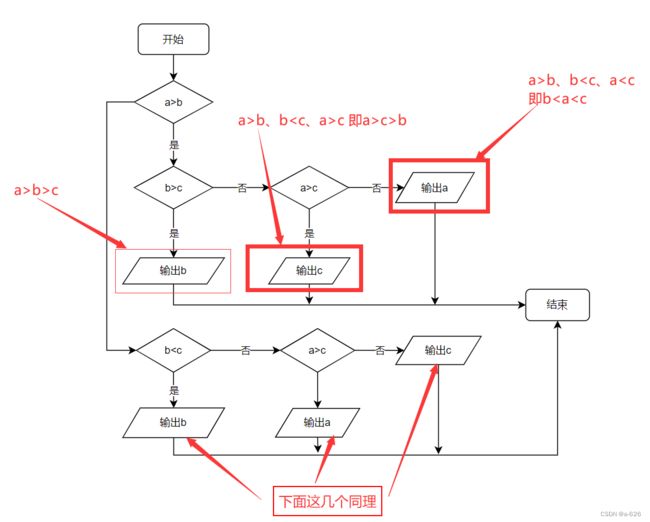假期刷题打卡--Day10
一、C语言刷题
预处理命令模块的题目就只有几个,下面开始选择结构这个模块的题目。
1、MT1112中庸之道
请编写一个简单程序,输入3个整数,比较他们的大小,输出中间的那个数
格式
输入格式:
输入整型,空格分隔
输出格式:
输出整型
样例 1
输入:
1 5 3
输出:
3
解决思路
本题最基本的方法就是使用选择语句的嵌套解决,下面是分析过程:
实现代码
#include
using namespace std;
void cmp(int a,int b,int c){
if(a>b){
if(b>c){
cout << b;
}else{
if(a>c){
cout << c;
}else{
cout << a;
}
}
}else{
if(b 感悟
刚开始写代码的时候,遇到某些需要思考的题目,如果思维能力不是很强的话,最好那是拿出纸和笔画一画、写一写,不要一味的想。对于我自己来说,拿到一个问题的时候,刚开始可能有很清晰的思路,但是偶尔被打断或者自己越想越觉得漏洞百出,导致整个思维变得很乱,而我也不懒得拿出纸和笔慢慢思考,就导致放弃很快,最终的结果就是,啥也不会。所以我现在就吸取了这个教训,有什么稍微绕一点的问题,我就会在纸上画画,这样思路真的会清晰很多。所以,一定要自己画,一定要动手。
2、MT1116正整数
判断n是否为两位数的正整数
格式
输入格式:
输入为整型n
输出格式:
是则输出YES否则输出NO
样例 1
输入:
11
输出:
YES
分析过程
看到这个题目的时候,我的思路:
满足两位数的正整数的两个条件:
1、该数a大于0
2、a/10记count初值为0,最终值为2
所以按照这个思路,我就写了如下代码:
#include
using namespace std;
void judge(int n){
int count = 0;
if(n > 0){
while(n != 0){
count++;
n/=10;
}
//cout << count;
if(count == 2){
cout << "YES";
}
}
}
int main( )
{
int n;
cin >> n;
judge(n);
return 0;
} 我觉得这个思路没有什么错误,但是编译的时候只能通过两个用例
那么为什么会出错呢,就是因为的我的粗心大意,一心想着怎么满足这个题目要求,能让它成为“YES”,但是忽略了“NO”,除此之外,我在写循环的时候,忘了把n的值一起改变了,我还在想为什么会编译错误。这些错误在编程的过程中都不该出现的,这次出现了,就当长个教训吧。
实现代码
#include
using namespace std;
/*满足两位数的正整数,满足两个条件:
1、该数a大于0
2、a/10记count初值为0,最终值为2
*/
void judge(int n){
int count = 0;
if(n > 0){
while(n != 0){
count++;
n/=10;
}
//cout << count;
if(count == 2){
cout << "YES";
}else{
cout << "NO";
}
}else{
cout << "NO";
}
}
int main( )
{
int n;
cin >> n;
judge(n);
return 0;
} 3、MT1117两个负数
判断x、y、z中是否有两个负数。
格式
输入格式:
输入为整型x、y、z,空格分隔
输出格式:
是则输出YES否则输出NO
样例 1
输入:
1 2 3
输出:
NO
分析过程
最简单的办法就是三个分别去判断是否小于0,如果有两个小于0的,就输出“YES”,在此过程中一定要考虑到0的特殊情况,只要有两个小于0,那么不管另一个是0还是大于0都满足条件,而我第一次写的时候忽略了这一点,导致只通过了两个用例。
错误示范如下:
#include
using namespace std;
void judge(int x,int y,int z){
int count = 0;
if(x < 0){
if(y < 0){
if(z > 0){
cout << "YES";
}else cout << "NO";
}else{
if (z < 0){
cout << "YES";
}else cout << "NO";
}
}else{
if(y < 0){
if(z < 0){
cout << "YES";
}else cout << "NO";
}else cout << "NO";
}
}
int main( )
{
int x,y,z;
scanf("%d %d %d",&x,&y,&z);
judge(x,y,z);
return 0;
} 错误出现在0这个特殊位置,修改之后就成功通过了。
实现代码
#include
using namespace std;
void judge(int x,int y,int z){
int count = 0;
if(x < 0){
if(y < 0){
if(z >= 0){
cout << "YES";
}else cout << "NO";
}else{
if (z < 0){
cout << "YES";
}else cout << "NO";
}
}else{
if(y < 0){
if(z < 0){
cout << "YES";
}else cout << "NO";
}else cout << "NO";
}
}
int main( )
{
int x,y,z;
scanf("%d %d %d",&x,&y,&z);
judge(x,y,z);
return 0;
} 这是最基本的方法,当然在此基础上可以修改,就比如说可以使用&&、||等这些 逻辑运算符解决,代码行数会大大减少。
例如:
#include
using namespace std;
void judge(int x,int y,int z){
int count = 0;
if(x<0&&y<0&&z>=0 || x>=0&&y<0&&z<0 || x<0&&y>=0&&z<0){
cout << "YES";
}else{
cout << "NO";
}
int main( )
{
int x,y,z;
scanf("%d %d %d",&x,&y,&z);
judge(x,y,z);
return 0;
} 一定要注意0这个特殊情况!!!
明天继续吧。




